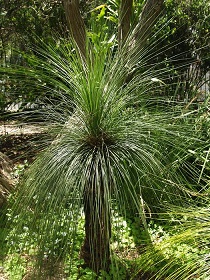 Broaden your plant knowledge and explore one of the most diverse and under used groups of plants in the world.
Broaden your plant knowledge and explore one of the most diverse and under used groups of plants in the world.
Are you inspired by plants and have a real passion for learning more?
Would like to try to grow plants that perhaps you know little or would
like to know more about?
Australian native plants are increasing in popularity in many countries throughout the world and are grown commercially as cut flowers in Israel and South America.
Eucalypts are widely planted trees throughout California, and is an increasingly popular specimen tree used in gardens of Southern England. Macadamia nuts and Tea Tree Oil are produced in commercial plantations not only in Australia, and beyond.
Australian climatic conditions range from hot-dry to cold - wet; soils also vary according to region from alkaline to acidic. Consequently the plant life of this large country is abundant and diverse, offering an interesting range of possibilities, whether you live in Australia or elsewhere. Many Australian natives are also well suited as indoor plants.
Duration: 100 hours
Content
There are nine lessons in this course, as follows:
1. Introduction
- Scope and nature of Australian indigenous plants
- Review of the system of plant identification
- Origins of Australian flora, and three main flora types
- General characteristics of Australian flora,
- Resources : Information contacts,: nurseries, seed, clubs
- Review of major Australian plant families.
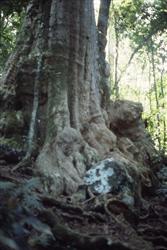 2. Cultural Techniques
2. Cultural Techniques
- Environmental factors
- Nutrition
- Pest and disease
- Soils, characteristics and management
- Watering and water management
- Drainage
- Limestone underlay technique
- Compost, no dig growing, feeding
- Pruning Australian plants
- Planting
- Staking
- Temperature requirements
- Mulching
- Plant Establishment ... special techniques
- Natives in Shade
- Weed Control
- Propagation of Australian plants
3. Eucalypts
- Sub groups (gums, stringy barks, messmates, boxes, etc)
- Hybrid Eucalypts
- General culture of the genus Eucalyptus
- Review of selected species
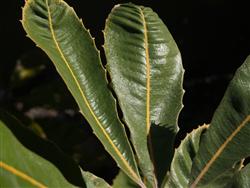 4. Native Trees
4. Native Trees
- Casuarina, Allocasuarina, Gymnostoma and Ceuthostoma
- Macadamia
- Australian conifers
- Callitris
- Araucaria
- Palms, etc.
5. Acacias
- Overview of Acacias -scope and nature
- Cultural needs of Acacias
- Review of popular Acacia species
- Drawing a garden Design
- Using plants effectively in the garden
6. Melaleucas, Callistemons and Leptospermums
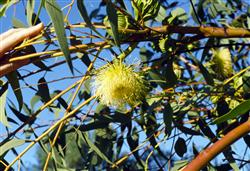 Review of the Myrtaceae family
Review of the Myrtaceae family- Callistemon ... culture, profile of popular species
- Leptospermum
- Baeckea
- Calothamnus
- Calytrix
- Eugenia
- Homoranthus
- Kunzea
- Melaleuca
- Scholtzia
- Syzygium
- Verticordia
- Thryptomene
7. Grevilleas
- Scope and nature of the genus
- General culture of Grevilleas
- Types of Grevilleas ... classified according to flower type ...erect, pendant, toothbrush, cylinder
- McGilveray classification system intoeleven main groups
- Describing Grevilleas ... using botanical terms
- Low growing Grevilleas
- Banksii types
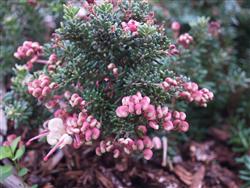 Warm climate Grevilleas
Warm climate Grevilleas- Poorinda hybrids
- Other popular Grevillea species
- Related Proteaceae Natives
- Dryandra
- Hakea
- Banksia
- Telopea
8. Ground Cover and Small Shrubs
- Fabaceae (Papillionaceae) Pea Family Australian Plants
- Boronias
- Prostanthera
9. Commercial Applications
- Fragrant Australian Native Plants
- Cut flowers, Bird attractants, timber, bush tucker, etc
- Growing Australian Plants in containers
EXAMPLES OF THINGS YOU MAY DO
- Compile a series of plant reviews with information on each plant variety, such as:
- Common Name, Plant Family, Genus & Species names, Variety (if applicable), Height, Width, Soil requirements, Environmental requirements, Cultural procedures (eg. propagation and pruning), Pest and disease susceptibility
- Visit nurseries and/or gardens and observe Australian plants
- Classify most significant cultivated native plants, to the family level.
- Determine cultural practices to maintain healthy native plants.
- Explain the identification and culture of eucalypts in your locality.
- Explain the identification and culture of native trees.
- Explain the identification and culture of acacias in your locality.
- Explain the identification and culture of native shrubs, including species of Acacia, Melaleuca, Callistemon and Leptospermum.
- Explain the identification and culture of different Proteaceous native plants, with particular emphasis on the genus Grevillea.
- Explain the identification and culture of a range of Australian Native ground covers and small shrubs.
- Determine commercially viable applications for different native plants.
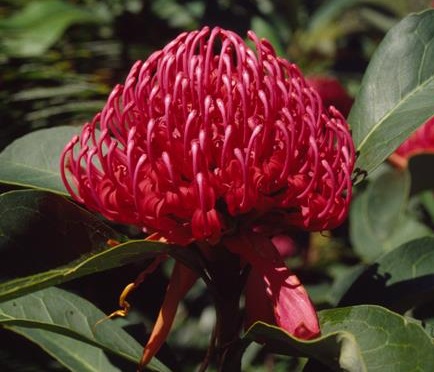
GET INSPIRED!
Australian plants are relatively new to horticulture; and as such they are presenting landscapers and gardeners with possibilities which are often uncommon. To set your garden(s) apart, creating an excitement and uniqueness that might not be seen elsewhere, consider Australian plants as an option to replace anything -ground cover, border, shrub, tree, or whatever.
Australian border plants can be trimmed into shape just as much as any other plants; to act as borders in a formal garden, or used along with other formal features to introduce some informality into an otherwise formal space. Following are some stunning natives that will suit any garden style including formal gardens as many can be pruned to shape or provide a ‘natural’ formality to edge borders. Some also provide architectural interest such as Lomandra, Dianella and the stunning Acacia cognata which looks amazing as focal point in the garden, as a stylish edging plant or cascading over a tall pot or low wall.
Try These:
Acacia cognata
A. cognata ‘Mini Cog’ is a dwarf compact form of this stunning low weeping native which makes an excellent garden edging plant. Other dwarf cultivars worth sourcing include: A. ‘Bower Beauty’, A. ‘Dwarf Dazzler’, A. ‘Fettucune’, A. ‘Limelight’ (dwarf form), and A. ‘River Cascade’.
Argentipallium dealbatum (syn. Helichrysum)
The cultivar A. 'Cardigan River Carpet' is a suckering everlasting daisy with pink-tinged buds that open to white from mid-spring to mid-autumn. It is not as drought-tolerant as some plants but worthy of inclusion as a border edging plant.
Brachyscome
These lovely, brightly flowered groundcovers come in several colours including white, blue, violet, mauve, pink, and even a creamy yellow. If planted en masse, they make a magnificent display. They are easy-care plants that just require an annual cutting back since new growth sprouts from the centre of the plant. They make a great low-care but pretty and tough edging plant. B. multifida (the Cut Leaf Daisy) and B. iberidifolia (the Swan River Daisy) are two well-known garden species.
Correa
These long-flowering woody plants, most of which are suitable for edging and low hedges, and are hardy in most situations. They produce small trumpet-shaped flowers that attract nectar feeding birds. C. ‘Dusky Bells’ is an old favourite that performs well, and should be used more often for its form, leaves and flowers. It is a very viable, healthier, disease-free replacement for the ubiquitous azalea. It is quite drought tolerant too. This cultivar grows to about 1m high with a spread of about 2m. It should be tip-pruned to encourage bushiness. The spreading form of the white flowering Correa, Correa alba (prostrate form), grows to only 30cm high with a spread of about 2m. It responds well to regular clipping. Correa decumbens is another low-growing spreading shrub with pink flowers.
Dianella
This plant is a no-fuss, drought-tolerant plant with an upright strappy habit. It makes a great edging plant or can be used as a low hedge or border plant. There are now several lovely cultivars available that will fit into most garden planting schemes. Dianella caerulea, D. tasmanica and D. revolute are the best-known species from which many modern cultivars have been bred. Most of these are improved forms of the species and include: D. ‘Blaze’, D. ‘Cassa Blue’, D. ‘Little Jess’, D. ‘Little Rev’, D. ‘Revelation’, D. ‘Tas Red’, and more.
Leucophyta
Leucophyta brownii (Silver Bush or Cushion Bush) is a well-known and used small shrub with stunning silver foliage. L. ‘Nana’ is a cultivar that is an improved form of the species and this has been around for several years. Newer good performers that are useful as edging plants include L. ‘Silver Nugget’ and L. ‘Silver Clouds’.
Lobelia
Lobelia alata is a pretty, small trailing plant that prefers moist but well-drained soil, and will flower in sun or shade.
Lomandra
Like Dianella, the genus Lomandra (another strappy plant) has undergone a revolution in hybridisation with many new cultivars improving on the natural species. The leaves of these cultivars are neater with less dieback. Species include: L. affinis, L. confertifolia, L. fifliformis, L. hystri, L. longifolia, and L. glauca.
New cultivars that suit the garden as an edging plant or as a focal point in the border include: L. affinis var. cylindrical, L. ‘Lime Cascade’, L. confertifolia ‘Little Con’, L. confertifolia ‘Little Tuffy’, L. ‘Bateman’s Bay’, L. filiformis ‘Blue Moon’, L. filiformis ‘Ice Queen’, L. glauca ‘Aussie Blue Grass’, L. longifolia ‘Lush Green’, and L. longifolia ‘Tanika’.
Pimelea
Pimeleas (Rice Flowers) are another plant suitable for edging and hedging. Although not as hardy or long-lived as Correas, they nevertheless have attractive white or pink flowers. Some, such as Pimelia nivea also have very attractive foliage. P. sylvestris, known as the Edna Walling Rice Flower, is a small shrub to about 50cm and a 20-30cm spread. P. ferruginea cultivars include: P. ‘Bon Petite’, P. ferruginea ‘Pink Solitaire’, P. f. ‘Snowball’, and P. f. ‘Magenta Mist’. Other cultivars worthy of inclusion here include: P. rosea ‘Deep Dream’, P. ‘White Jewel’, and P. ‘Solitaire’.
Scaevola
Scaevola eamula (Fairy Fan Flower) is a gorgeous ground-hugging plant to 60cm tall that is ideal as a border edging plant. It comes in mauves, blues and purples with a yellow centre. S. aemula ‘Mauve Clusters, S. a. ‘Purple Fanfare’, S. a. ‘Flat Mat’ and S. a. ‘Jumbo Purple’ are good performers as is S. humilis ‘Purple Fusion’.
Thryptomene
Thryptomene saxicola ‘Saxicola Compact’ is a tight, small shrub (30cm x 50cm) that produces a mass of stunning pink flowers for many months of the year – it would make a great edging plant.
Viola
The Australian native violet, Viola hederacea, produces delicate yet vibrant white flowers with purple centres throughout most of the year, and especially over the summer when it flowers profusely. The leaves are bright green and kidney shaped so the plants look lush and attractive even without flowers. They can be used as a low border or edging plant providing ground cover. They are also a good option in shady spots and will thrive in dark, damp places where other plants may not do so well.
Why Study with ACS?
Design your own learning pathway.
Study at your own pace, from anywhere, at any time.
Receive prompt, expert support from our team of committed and friendly tutors.
Your learning is our priority. We are flexible and adaptable to meet your educational needs!
WHAT NEXT?
Enrol
Go to “It’s Easy to Enrol” box at the top of the page and enrol now.
Get Advice
Email us at info@acsedu.co.uk or use our FREE COUNSELLING SERVICE to contact a tutor.